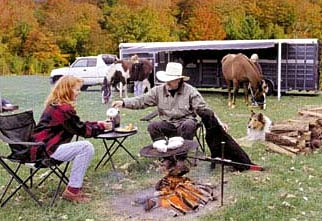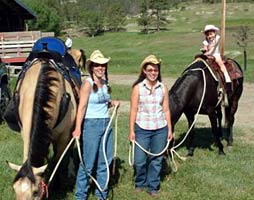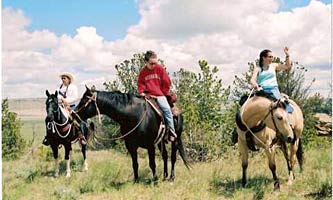|
Horse Camping: Containing Your Horse 
by Melissa Sipe, President Horsin Around Outdoors
You're sitting under the stars around the campfire eating and relaxing with friends after a long day
horseback trail riding. Your camp is all set, the tent is up, sleeping bag is unrolled, and your horses are…where ARE your horses?
 If you've always wanted to camp with your horses, but are
worried about where and how you will keep them safely contained when you're not on them, there are several horse containment options for horse camping. Choosing the type of
containment you will use depends on where you camp and your horse. Proper preparation with any of these containment options is the key to keeping your horses safe and in camp with you. If you've always wanted to camp with your horses, but are
worried about where and how you will keep them safely contained when you're not on them, there are several horse containment options for horse camping. Choosing the type of
containment you will use depends on where you camp and your horse. Proper preparation with any of these containment options is the key to keeping your horses safe and in camp with you.
So, how do you decide if you will use a portable corral, a portable electric corral, hobbles, picket lines, or a highline?
First of all, determine where you are camping:
Camping at a trail head or by your horse trailer requires a different containment than camping on the trail.
At the trail head, where there may be other campers, vehicles and horses, you probably want a portable
corral with panels that attach to your trailer to keep your horses safe and close to you. Sometimes, if you're lucky, the trailhead has corrals available.
Camping on the trail requires that you educate yourself about the rules and regulations for the area in which you are riding and camping. There may be limitations on grazing and stock containment.
Depending on where you are riding, you can generally get that information from the landowner or public
land officials such as a forest ranger. After learning about any rules and laws regarding horse camping, you then can decide what allowed containment option works best for you and your horse.
Next, you need to decide what works best for YOUR horse. This requires proper preparation and experimentation:
Grazing hobbles are an excellent option for your horse in areas where grazing is allowed, but it is vital to
your horse's safety and comfort to accustom them to hobbles prior to using them on the trail. You want
your horse to be calm (sometimes a little feed helps) and in a small corral or pen when you first try on
hobbles. Give the hobbles a tug after you put them on your horse, so he knows they are there and then
give him a chance to try them out. It's best to repeat this trial a few times and if you can, try them out in
larger pastures prior to using hobbles on the trail. If you are new to hobbles, know that there are different types and some are meant to make a horse stand still, while the grazing hobbles, usually
attached with a chain, allow them to move and graze. Using a horse bell in conjunction with hobbles is a
good way to give yourself peace of mind on the trail, but be sure to prepare your horse with the bell as well.
Picket lines also allow your horse to graze in a limited area. Using a picket stake with your line allows
you to put your horse in an open area, so you can avoid tree damage. You can picket by a foot with one
hobble or attach the picket line to your halter. Preparing your horse at home will let you know what works best. Again, start in a small corral or pasture.
First, attach the picket line and let your horse drag it until he/she is used to it.
Then drive the stake straight into the ground, so it won't pull out. Lead your horse to the end of the line
the first time and then let them graze. Again, it's best to repeat this trial a few times prior to heading out
on the trail. Horses sometimes tangle themselves in the line even if they are experienced on a picket line,
so you need to check on them often and you may want to use the picket line just for grazing during
daylight hours and use a highline at night. On the trail, try to place the picket stake where the line will not
get hung up on rocks, logs or trees to protect your horse and the environment. Also, if you camp in one
place for an extended time, be sure to move your picket often enough to prevent overgrazing and lower the impact on the environment.
Highlines are a good option for containment, and can be used in conjunction with hobbles or a picket line
. When tied to a highline, horses can walk around in a circle, lie down and even roll. For feeding, you
can give them enough lead rope to get their heads to the ground, as long as you are close by to keep an
eye on them. At night or when left unattended, you will want to shorten the leads to prevent the horse
from being able to get a leg over the rope. A highline can be hung from tree to tree using tree saver
straps. A good option is to let your horses graze (if grazing is allowed) using hobbles or a picket line
during daylight hours and put them on the highline during the night. If you are strictly using the highline,
you can also use standing hobbles to prevent your horse from pawing. Again, practicing at home is a good idea. Highline kits usually accommodate about four horses, so you can prepare more than one
horse. Ride or work your horses enough to get them a little tired (like they would be after a day on the
trail), make sure they are fed and watered sufficiently to make them content, and tie them on a short lead
to the highline for a short period (30 minutes) at first and then work up to longer time periods.
Portable electric corrals are another choice for the trail. Electric fence kits that operate off batteries and
are made specifically for the trail work great. Just make sure you practice setting up the corral at home and your horse is used to an electric fence.
 Practice and experimentation at home with
these different containment options is extremely important to preparing your horse and you for a safe and fun horse camping adventure. Some other things to consider when you are camping
on the trail are: Practice and experimentation at home with
these different containment options is extremely important to preparing your horse and you for a safe and fun horse camping adventure. Some other things to consider when you are camping
on the trail are:
Don't turn all your horses loose on hobbles at the same time.
Some can be tied to the highline while the other hobbled horses graze and when the hobbled
horses are sufficiently fed, you can swap. If you have three horses, leave two tied while one grazes, because tying just one may make the tied horse
nervous if he thinks his companions might be leaving.
If you have a dominant, leader horse to whom the other horses are very attached, that horse may need
to stay on a the picket line or the highline. Know your horses and know the other horses your companions are riding.
It's a very good idea to let your horses get safely acquainted with the other horses in your group prior to
camping on the trail, preferably with a safe sturdy fence or panel between them where they have room to get away from each other if necessary.
Sandy Gagnon of Montana University had some good advice at a recent MSU Equine Conference. An MSU Extension Equine Specialist, Gagnon teaches packing courses and a wilderness ecology course at
MSU. He advised setting up camp between the grazing area and trail head to make it easier to detect
horses trying to go home. Horses, however, should stay far enough away from camp so flies won't be a problem.
Mountain Horse, Inc.'s on line web store "Horsin' Around Outdoors" at
www.MontanaMountainHorse.com has all the horse containment products described above: several
types of horse hobbles, picket line kits and highline kits. They also carry Carri-lite Corrals and OK Corral kits. The Carri-lite Corral works great for horse camping at a trail head and provides
convenience in transporting because it collapses down to 1/5th or 1/6th its size. This portable stall can
stand alone or be secured to horse trailer with brackets and can fit in the mid-tack area, bed of truck,
even back seat! The OK Corral kit is a portable electric corral that packs easily for camping on the trail in a convenient cantle bag.
Choosing the type of containment you will use depends on where you choose to camp. It also depends on your horse and what you determine to be the safest and best containment option by experimenting
with the different products. Preparing your horses at home for containment on the trail with products from Mountain Horse, Inc. will help you have a safe and fun horse adventure on your next horse
camping trip!
Contact: Melissa Sipe, President Mountain Horse, Inc.
Phone 866-781-4465 toll free
Email: mtmountainhorse@yahoo.com
Website: www.MontanaMountainHorse.com
 |
|
 |
 |
 |
 |
 |
|
To advertise your horse product or service, contact Ann
|
|
|
|
InfoHorse.com, Horse Information Lives Here ® 12/4/2025
Contact Us to Advertise to over a
million Horse Owners.
All images and content Copyright© 2012 by InfoHorse.com, Equusite.com.
|
|
|
|
Articles, Academic Schools, Arena Maintenance, Animal Communicators, Barns, Barn and Accessories, Barn Equipment and Tractors, Breast Collars, Grooming Products for Horses, Hay Feeders, Horse Blankets, Horse Books, Horse Videos, Horse Breeders, Horse Camping Gear, Career Schools, Carts and Buggies, Horse Training Clinicians, Equestrian Clothing, Dogs and Puppies, Horse Fencing, Western Art & Furniture, Horse Property for Sale, Horse Products For Sale, Fly Control, Foal Care, Horse Footings, Horse Gifts, Horse Health and Nutrition, Hoof and Leg, Horse Insurance, John Lyons Certified Trainers, Equine Lawyers, Leather Care, Links, Horse Property, Horse Photography, Portable Horse Stalls, Arenas and Roundpens, Horse Riding Schools, Horse Schools, Safety Products, Services for Horses, Horse Trailers, Horse Shipping, Horse Skin Coat Care, Horse Software, Specialty Trainers, Horse Summer Camps, Tack, Horse Trainers, Treats and Snacks, Truck Accessories, Trucks, Horse Vacations, Western Lifestyle, jewelry
|
|
|
|